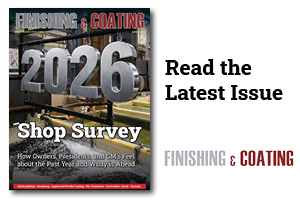Zinc plating was first developed in the 1800s, and the first bright zinc-plated deposits were obtained from cyanide zinc baths in the early 1930s.
 Stephen Rudy CEFThe Ford Motor Company developed chromate conversion coatings as paint primers in the late 1920s, which significantly improved corrosion protection. Finishers modified chromate conversion coatings, adapting them in a range of corrosion protection effectiveness over plated zinc parts.
Stephen Rudy CEFThe Ford Motor Company developed chromate conversion coatings as paint primers in the late 1920s, which significantly improved corrosion protection. Finishers modified chromate conversion coatings, adapting them in a range of corrosion protection effectiveness over plated zinc parts.
Commercial zinc coatings are very effective for enhancing corrosion protection and thus extending the service life of finished parts. Typical of these parts include construction & fasteners, automotive functional, and marine environments. The service life of zinc coatings is a function of thickness and types of environmental exposure.
ASTM B633-23 is a standard specification for electroplated zinc on iron and steel.
| Zinc thickness (inches) | Application |
| 0.00022 | Industrial |
| 0.00006 | Non Industrial or Marine |
| 0.00005 | Suburban |
| 0.00003 | Rural |
| 0.00002 | Indoor |
Zinc is electroplated from acid, alkaline, and cyanide plating baths. Zinc is also deposited in a cold tumbling process by impacting zinc powder onto the substrate using glass beads. This process is commonly referred to as mechanical plating. Zinc alloy baths containing metals such as iron, nickel, and tin have a typical application for functional, high corrosion protection requirements.
The focus here will be on traditional zinc coatings and post-top coats to improve overall corrosion protection for zinc coatings over steel. Process baths and their performances are considered to be optimum.
The thickness of the zinc deposited is most critical to achieving the desired corrosion protection. Most requirements specify at least 0.00025” thickness. The zinc coating may range up to 0.0005” depending on the specific need. Mechanical zinc thicknesses may reach 1 mil because of the process’ ability to build a relatively stress-free, non “dog-bone” deposit buildup.
Determining Zinc Deposit Thickness
There are several methods used to determine the zinc deposit thickness. The procedures listed are briefly described.
X-Ray: This is a popular, non-destructive method. Many platers make direct measurements of sample parts while a load is being plated and as a function of post-finishing quality control approval. It is a very accurate method, offering precise data in relatively small or discreet areas of the surface. X-rays are produced, and emitted radiation is measured from the base metal and zinc coating.
Magnetic: The instrument works on the magnetic field system. It detects thickness by the difference between the base metal substrate (steel or iron, which are magnetic) versus the zinc coating, which is non-magnetic.
Coulometric: This instrumental method is used in reverse plating or de-plating applications. The zinc deposit is anodically dissolved. The ampere-minutes or coulombs required are determined and calculated as the initial deposit thickness.
Cross-Section: This procedure requires some time and implementation by trained personnel. A section of the finished part is cut on a plane perpendicular to a significant surface. After it is mounted, the section is polished to contrast with the base metal. Thickness is determined microscopically.
Weight Loss: The subject part is weighed. Afterward, the zinc coating is chemically stripped while not etching the undercoat or base metal. The coating weight is determined by weight difference.
These are the most common thickness measurements. The X-ray method seems to be the most popular one in current use.
Chromate Post Plate Dips
Chromate post-plate dips provide excellent corrosion protection to zinc-plated parts. The coating which forms with the zinc surface is a first-line barrier to the effects of oxidation while extending the intended service life of finished parts.
Much attention has been focused on the development of trivalent chromates based on stricter environmental regulations and meeting the requirements of RoHS. The advent of trivalent chromates greatly improves the corrosion resistance of zinc-coated parts. Over 120 hours can be achieved by applying trivalent blue chromates. Trivalent chromates significantly benefit and improve waste treatment. These baths extend operating service life 2-4 times compared to that of similar color hexavalent chromates. Extended service life maintains consistent salt spray protection. The environmental hazards associated with hexavalent chromium are eliminated. Colored chromates in industrial use include clear (blue), yellow, black, and olive.
Typical salt spray hours for colored chromates over 0.0003” of deposited zinc, per ASTM B-117, are:
| Chromate | Hours to White Corrosion |
| *Clear | 10-25 |
| Iridescent yellow | 75-95 |
| Black | 75-95 |
| Olive Drab | 145-300 |
*Also referred to as blue
The above salt spray data pertain to a moderate exposure condition, which is usually dry and indoors with periodic wear and condensation. For direct exposure to condensation and periodic rain, the equivalent salt spray data would require a zinc coating thickness of 0.0005”.
Additional Corrosion Tests
Additional corrosion tests of zinc-plated and chromated parts include:
Cyclic Corrosion Test: It is a series of exposure tests that may comprise neutral salt spray or fog, followed by hot air blowing, followed by high humidity. This is usually a cycle, such as 8 hours in total for all three described exposures, in a proportional ratio.
Lead Acetate: This is a destructive spot test whereby a 5% solution drop of lead acetate is observed on a section of the finished part. The time required for the test solution to darken is compared to the time for non-chromate to provide an additional level of corrosion protection. Some of these post-treatments also provide thermal shock resistance, improved surface friction, and solderability. Sealers may also contain dyes, which are absorbed by chromate, offering varying colors for aesthetic and industrial applications. Sealers include the following types:
Inorganic: These are based on silicon chemistry. They may be as silica or inorganic silicates. This type of sealer converts the chromate coating to a silicate passivate. Salt spray protection upwards of 300 hours to white corrosion and 500 hours to red rust can be achieved. It provides ideal protection for wire goods and fasteners.
Wax: The dip forms a mechanical barrier. It effectively seals off the previously exposed chromate film. Where required, the coefficient of friction is greatly reduced. Salt spray protection of 300 hours to white corrosion can be obtained.
Polymer: It also forms a mechanical barrier, sealing the previously exposed chromate film. The finish can be glossy or even colored, per dyes in the polymer film. Salt spray protection of 300 hours to white corrosion can be obtained.
Zinc Facts
Zinc is the 23rd most abundant element in Earth’s crust. This is equivalent to 2.3 ounces of zinc for every ton of Earth’s crust. Over 14 million metric tons of zinc are produced annually worldwide. Over 7 million tons of zinc is used for plating and galvanizing steel.
Stephen F. Rudy, CEF, is president of Chem Analytic and has written extensively about the finishing industry. Visit www.chemanalytic.com or call him at 917-604-5001.

































